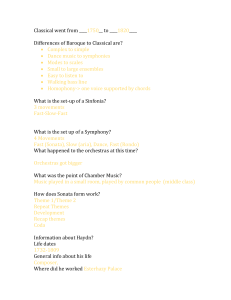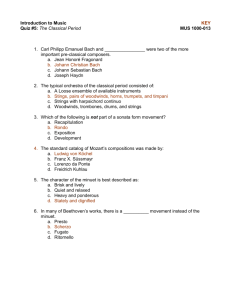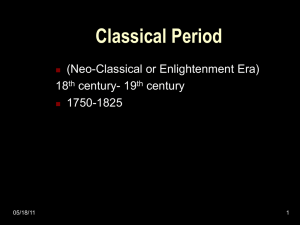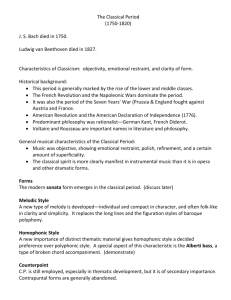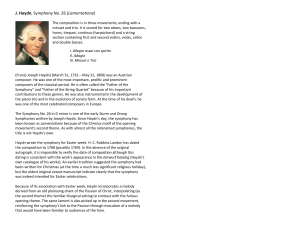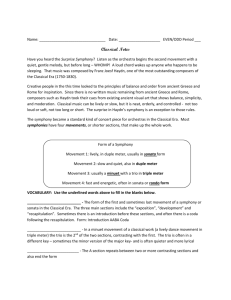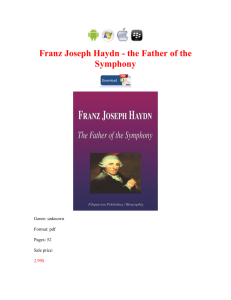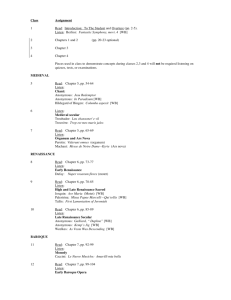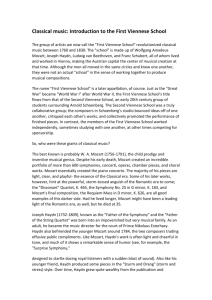Classical Era Test 3
advertisement
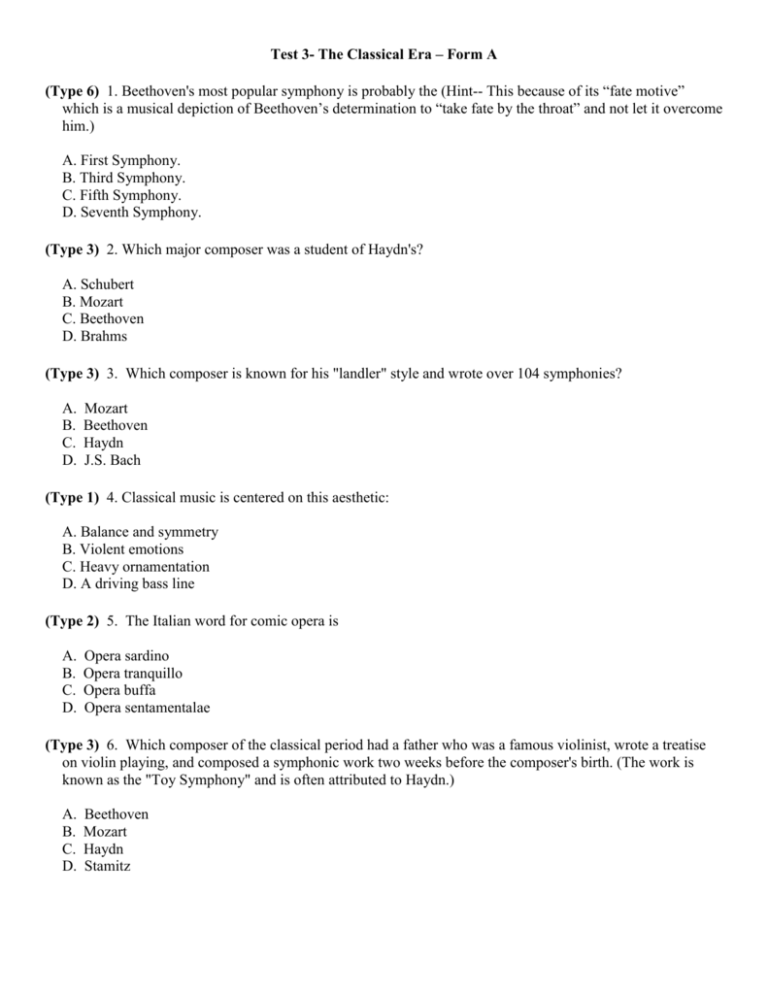
Test 3- The Classical Era – Form A (Type 6) 1. Beethoven's most popular symphony is probably the (Hint-- This because of its “fate motive” which is a musical depiction of Beethoven’s determination to “take fate by the throat” and not let it overcome him.) A. First Symphony. B. Third Symphony. C. Fifth Symphony. D. Seventh Symphony. (Type 3) 2. Which major composer was a student of Haydn's? A. Schubert B. Mozart C. Beethoven D. Brahms (Type 3) 3. Which composer is known for his "landler" style and wrote over 104 symphonies? A. B. C. D. Mozart Beethoven Haydn J.S. Bach (Type 1) 4. Classical music is centered on this aesthetic: A. Balance and symmetry B. Violent emotions C. Heavy ornamentation D. A driving bass line (Type 2) 5. The Italian word for comic opera is A. B. C. D. Opera sardino Opera tranquillo Opera buffa Opera sentamentalae (Type 3) 6. Which composer of the classical period had a father who was a famous violinist, wrote a treatise on violin playing, and composed a symphonic work two weeks before the composer's birth. (The work is known as the "Toy Symphony" and is often attributed to Haydn.) A. B. C. D. Beethoven Mozart Haydn Stamitz (Type 3) 7. The third movement of Beethoven's Fifth Symphony is a A. sonata form. B. theme and variations. C. scherzo and trio. D. minuet and trio. (Type 6) 8. Which Mozart opera recounts the story of a Spanish lover who has many romantic escapades, but is made to account for these romances and for killing the father of one of his lovers? A. B. C. D. The Abduction from the Seraglio The Magic Flute Don Giovanni The Marriage of Figaro (Type 6) 9. From the movie Amadeus which ruling Austrian monarch indicated to Mozart that his opera, The Abduction from the Seraglio had "too many notes?" A. B. C. D. Archbishop Collorado Emperor Joseph II Joseph Stallin Prince Esterhazy (Type 3) 10. A structural form based on a theme followed by alternate versions of that theme is a A. rondo. B. theme and variations. C. sonata rondo. D. scherzo and trio. (Type 3) 11. Which composer of the classical era was completely deaf during the last ten years of his life similar to Berich Semtana of the Romantic Period? A. B. C. D. JS Bach Mendelssohn Beethoven Haydn (Type 2) 12. A string quartet contains A. four violins. B. one violin, one viola, one cello, and one bass. C. two violins, one viola, and one cello. D. two violins and two violas. (Type 3) 13. Franz Joseph Haydn's most lucrative position was A. as a music director for Prince Esterházy. B. as a music director for the emperor of Austria. C. as a music director of St. Stephen's in Vienna. D. as music director of the Royal Opera House in London. (Type 3) 14. Symphonies are structured using A. a two-movement form based on the French overture. B. a multimovement form based on a series of dances. C. a four-movement plan beginning with a sonata-form movement. D. a three-movement plan beginning with an adagio movement. (Type 3) 15. Which composer of the classical period had an unhappy marriage similar to that of Hector Berlioz and Peter Tchaikovsky of the Romantic era? A. B. C. D. Beethoven Mozart Haydn Stamitz (Type 3) 16. In which rural village in Austria did Beethoven write his famous testament in which he wrote that his music would prevent him from taking his own life? A. B. C. D. Vienna Salzburg Heligenstadt Bonn (Type 2) 17. Classical operas that have both comic and serious elements combined are known as A. B. C. D. bel canto operas singspiel operas giocoso operas opera buffas (Type 4) 18. The director of the Mannheim Orchestra and the man credited with instituting the "crescendo" and "diminuendo" into the music of the eighteenth century was A. B. C. D. Johann Stamitz. Wolfgang Amadeus Mozart. Ludwig von Beethoven. Franz Joseph Haydn. (Type 3) 19. A rondo is a movement structure A. in sonata form. B. in which the first theme keeps returning similar to a refrain C. in ternary form. D. in minuet and trio form. (Type 2) 20. The two forms of second movements of symphonies and concertos in the classical era are theme and variations and A. B. C. D. rondo sonata da capo minuet and trio (Type 4) 21. Which city in Europe was considered to be the musical center of the classical period? A. B. C. D. Vienna Rome Paris Venice (Type 3) 22. After Haydn gained his independence from the second Prince Esterházy, he worked for an impresario in A. Vienna. B. Paris. C. New York. D. London. (Type 4) 23. Composers preferred writing concertos for which solo instrument during the classical era? A. B. C. D. bassoon clarinet violin piano (Type 4) 24. The most important chamber ensemble during the classical period was the A. string quartet. B. piano trio. C. piano quintet. D. string trio. (Type 6) 25. The symphony of Haydn that is known as the "farewell symphony" because near the end of the final movement, the musicians leave the stage one by one is symphony no. A. B. C. D. 88 104 94 45 (Type 4) 26. Which country of Europe emphasized "bel canto" or beautiful singing melody as its primary feature? A. B. C. D. Italy France Belgium Germany (Type 1) 27. In the concerto, the themes of the sonata form A. are stated twice– once by the orchestra and once by the soloist. B. not introduced in the exposition. C. are introduced only once in the exposition–by the orchestra. D. are introduced in the development. (Type 2) 28. Which oratorio of Haydn is know for its extensive use of word painting or thonmalerey? A. B. C. D. The Messiah The Magic Flute The Creation The Prince and the Pauper (Type 3) 29. The man called the "Father of the Symphony" was A. Wolfgang Amadeus Mozart. B. Johann Stamitz. C. Franz Joseph Haydn. D. Ludwig von Beethoven. (Type 3) 30. Which movement of a classical symphony is usually the minuet and trio ? A. First B. Second C. Third D. Fourth (Type 3) 31. When Haydn lived at the Michaelerhaus, he became acquainted with three very famous musicians and patrons of the arts. The most notable librettist of the eighteenth century also lived there. His name was A. B. C. D. Johann Stamitz Pietro Metastasio Nicolo Porpora Isaac Stern (Type 4) 32. In which city was Mozart’s only bassoon concerto composed? A. Vienna B. Paris C. Salzburg D. Mannheim (Type 5) 33. The opera which Mozart considered to be his most comic opera is A. The Abduction from the Seraglio B. Idomeneo C. The Pirates of Penzance D. Don Giovanni (Type 3) 34. The movement present in a symphony but missing from the classical concerto is A. the sonata-form movement. B. the minuet and trio. C. the slow, contrasting movement. D. the fast finale. (Type 2) 35. A rondo that includes a development section is called a A. developmental rondo. B. rondo with development. C. standard rondo. D. sonata rondo. (Type 3) 36. Which classical composer was born in Salzburg, Austria, the city where the popular musical The Sound of Music was filmed? A. B. C. D. Beethoven J.S. Bach Mozart Haydn (Type 1) 37. The style of early classical music which had its counterpart in the artistic term known as the rococo is known as the A. B. C. D. style improvisorio style gallant style romanesque style de Pari (Type 4) 38. The instrument that Prince Esterházy played, and for which Haydn composed, was the A. organ. B. baryton. C. flute. D. guitar. (Type 2) 39. The section of a concerto where the performer can show off his or her skills is called the A. cadence. B. staccato. C. cadenza. D. trill. (Type 6) 40. Which London symphony of Haydn has a "surprise" in the second movement in which a very loud note is sounded to wake up the audience who were being rude because of drinking too much before the concert began was symphony number A. B. C. D. 34 45 94 101 (Type 1) 41. The most notable characteristic of Mozart's operas is that of A. B. C. D. thematic development bel canto arias lively recitatives character delineation (Type 3) 42. One of the most famous cathedrals in Vienna where Haydn sang from the age of 8 until his voice changed was A. B. C. D. St Mark's Cathedral St John's Cathedral St Peter's Cathedral St Stephen's Cathedral Listening Portion for Test 3 The Classical Period Directions: Place the correct letter choice to the left side of each number. ______ 43. Listening Example Number 1 (Type 5) ______ 44. Listening Example Number 2 (Type 5) ______ 45. Listening Example Number 3 (Type 5) ______ 46. Listening Example Number 4 (Type 5) ______ 47. Listening Example Number 5 (Type 5) ______ 48 Listening Example Number 6 (Type 5) ______ 49. Listening Example Number 7 (Type 5) ______ 50. Listening Example Number 8 (Type 5) ******************************************************************************************** A. Beethoven Symphony No. 5, Fourth Movement B Beethoven Symphony No. 5, Third Movement C. Beethoven Symphony No. 5, Second Movement D. Beethoven Symphony No. 5, First Movement E. Mozart, Piano Concerto No. 23 in A Major, First Movement F. Mozart, Don Giovanni Act 1: Excerpt from Opening Scene G. Beethoven, String Quartet in C Minor Fourth Movement H. Mozart, Eine kleine Nachtmusik Third Movement I. Haydn, Symphony No. 94 Second Movement J. Mozart, Symphony No. 40 First Movement
